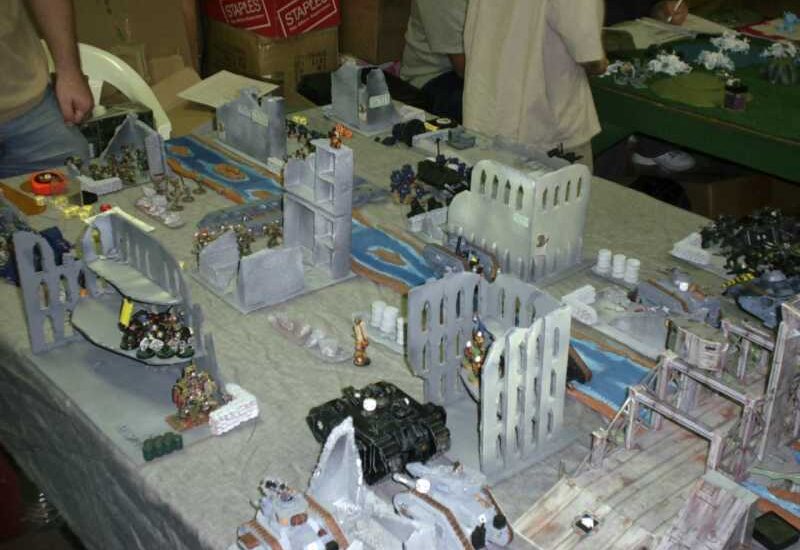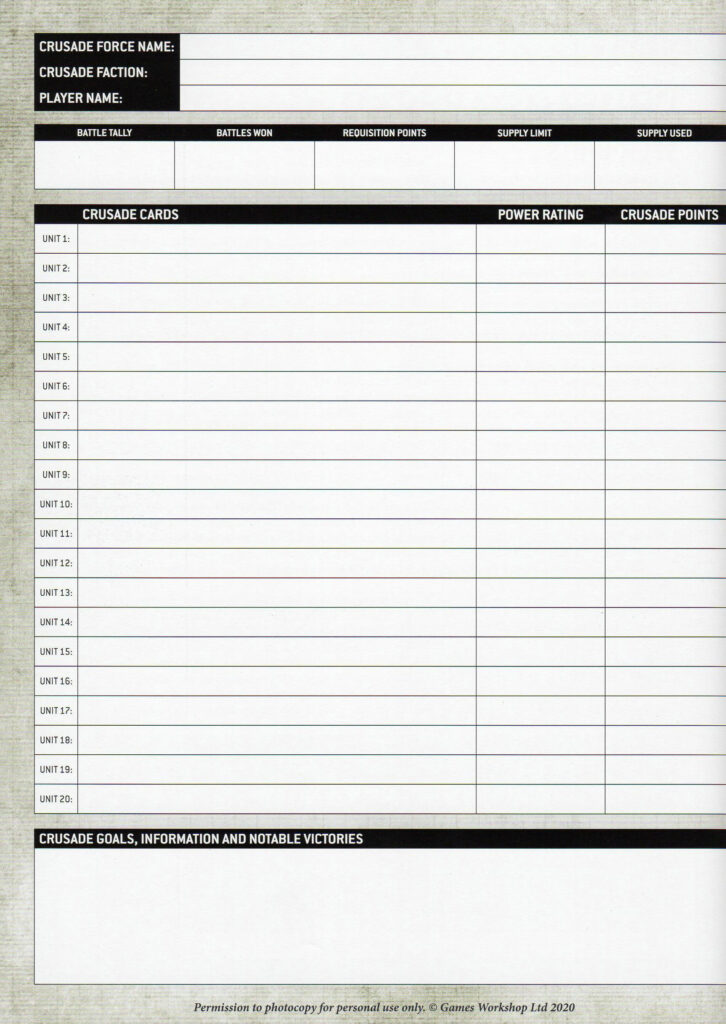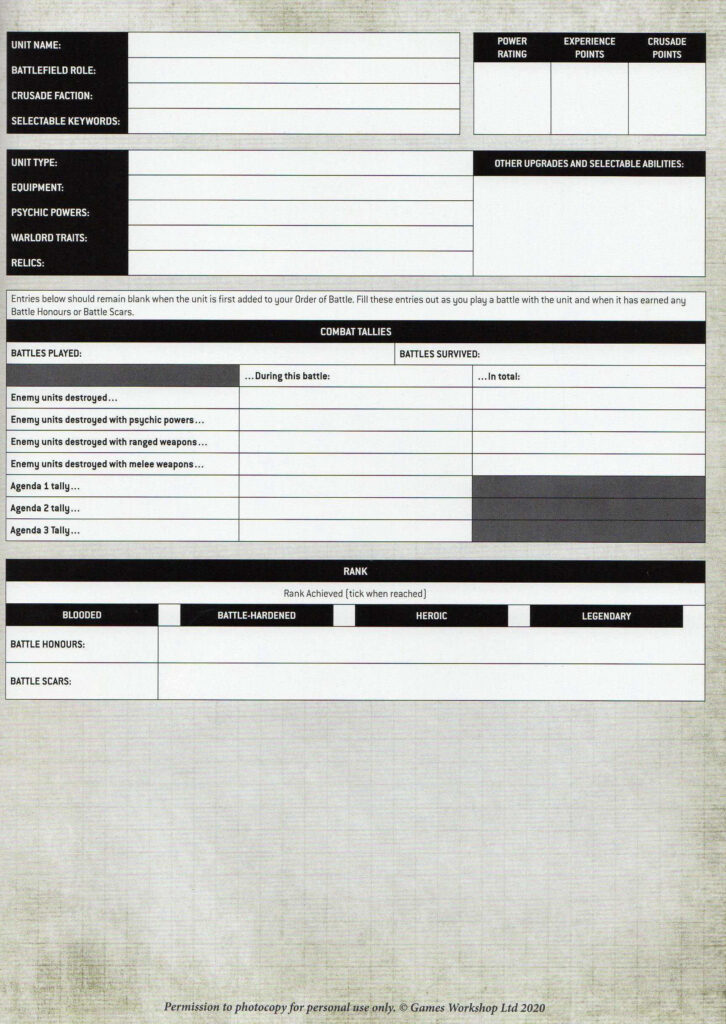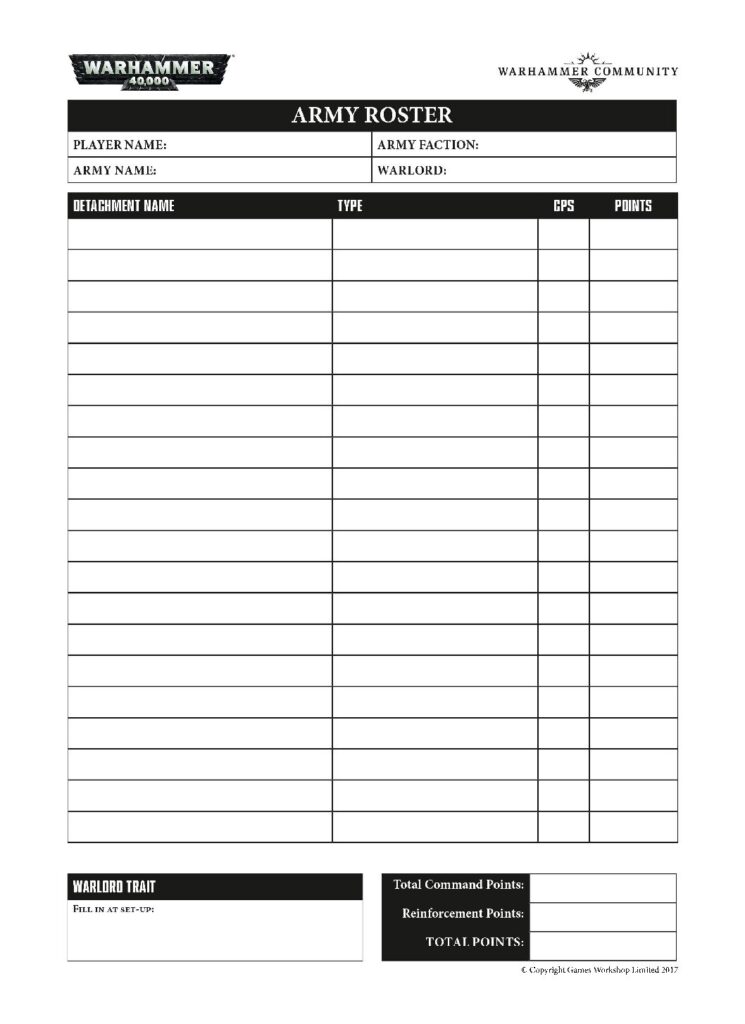** UPDATE: With the release of 10th edition Warhammer 40K, this entry is no longer valid! **
My local group is starting a narrative Crusade, and so I finally got the impetus to really dive in…

Good times.
I can say with all honesty, GW’s rules here are clear as lake water. Sometimes you can see all the way down, and sometimes you lose sight of things just below the surface. So here is how I think everything works, from creating your Crusade force to fighting your first battle. This also includes how to muster your army for that fight!
Points are points? Nope.
There are several different types of points you have to keep track of, and this is where the confusion can start.
- For your Crusade Force
- Power Rating (PR) – How much a unit costs to add to your Crusade Force, each unit in your Codex has one on their Datasheet. This may not exceed your Crusade Force’s Supply Limit.
- Supply Limit (SL) – The limit for ALL of your Crusade Units, which starts at 50 PR. Your total PR may be less than your SL if you haven’t added Units to your Crusade Force List after spending Requisition Points to increase your Crusade Force’s SL.
- Requisition Points (RP) – Points to spend on improving your Crusade Force List. Typically, you start with 5 RPs. Generally, a good idea to keep a few in reserve. The three main things you spend these on at start is to purchase Warlord Traits, Relics, and/or increase your SL.
- You may never go above 5 RPs. So if you have 5 RPs before a battle, you do not gain one afterward!
- 1 RP = 5 SL
- Crusade Points (CP) – Tracked for each Unit in your Crusade Force, this is how you compare the actual effectiveness of your experienced units when two players fight a battle.
- Experience Points (XP) – Tracked for each Unit in your Crusade Force, allows you to purchase Battle Honors, which are ways to upgrade the abilities of a Unit.
- When you muster any army for battle
- Power Rating (PR) – How much each Unit in your army costs to field.
- Power Level (PL) – The total value of your Army.
- Maximum Power Level (MPL) – How many PLs you may field in a given battle.
- Crusade Force Lists start at 50PL, which means you may only play Combat Patrols at the beginning of a Crusade!
- Crusade Points (CP) – The effectiveness of a given unit. Each player adds up the total CPs of their army, and whomever has the lower number gains extra Command Points for that battle.
- Command Points (CP) – Points used to purchase Stratagems before and during the battle. Since this has the same abbreviation as Crusade Points, we’ll call these Battle Command Points (BCP).
- Combat Patrol missions provide 3 BCPs
- BCPs are also used to buy your Detachment(s). Combat Patrol armies may only have 1 detachment.
Building your Crusade Force
Tasks:
Choose your Faction.
Add Units to your Order of Battle roster.
Spend Requisition Points.
Write up your Order of Battle roster and your Unit’s Crusade Cards.
It’s dangerous to go alone. Take these:


PDF versions:
The first one is your Crusade Force List. Every Unit in your Crusade Force must be listed here. The second is a Crusade Unit Card. Every Unit in your Crusade Force must have one of these. There are digital versions of these out there, so it doesn’t matter what you use. However, all of this must be available for anyone to take a look at!
The best rules reference on the internets, hyperlinked and up to date:
Wahapedia.ru – All the rules for Warhammer 40K, Kill Team, and Age of Sigmar!
Choose your Faction
When you start a Crusade force, you must decide what its Crusade Faction will be – this must be one of the following Faction keywords:
- IMPERIUM
- CHAOS
- AELDARI
- TYRANIDS
- ORKS
- NECRONS
- T’AU EMPIRE
In a Crusade force, all of the units in your Order of Battle Roster, with the exception of those that are UNALIGNED, must have at least one Faction keyword in common (e.g. IMPERIUM or CHAOS). If a unit does not have the correct Faction keyword, it cannot be included in your Order of Battle.
Build your Order of Battle
You have 50 PRs of Supply Limit to build your initial Crusade Force. You do NOT need to spend your entire Supply Limit! You can save some for later additions*. Use your Codex’s Datasheets (and GW’s various updates) to select your units. Any upgrade that increases the PR of a unit must be applied (an example of this is adding jetpacks to certain Space Marine units). Create a Crusade Unit Card for the unit, give it a name, and write down all of the options and/or wargear you’ve selected for that unit.
*Maybe you've only painted 30 PRs worth of forces, or you want to reserve some flexibility after encountering your first opponents. Remember, all you really need for your first battle (a Combat Patrol) is 25 PR worth of units! So you could set aside the other 25 PR and fill them in as you paint new units, or realize that you need some opponent-specific firepower!
Characters
You should have at least one model with the Character keyword. Only models with the Character keyword may gain Warlord Traits. While you can muster any army without any Characters, you will be at a disadvantage.
No changes without spending RPs
THIS IS CRITICAL: Once you choose your unit’s options, they may not be changed! The only way to change a unit is to spend an RP. So think ahead about this, and remember you will not be allowed to make changes based on your opponent’s army, etc. on-the-fly. Got a Devastator Squad full of heavy bolters and you’re facing a ton of tanks or monsters? No lascannons for you! Want to change your psyker’s powers? Hard nope.
This also includes your unit’s <Faction Keywords>. For example, if an Astra Militarum player choses Krieg as their unit’s <Regiment> that’s forever where they are from. This means once you lock this in place, you typically must use those for your Detachments. So units in an Astra Militarum Detachment must all share the same Faction to gain the benefits of being in that Detachment. Necrons starting in the Szarekhan Dynasty and want to defect to the Novokh? Your units will remain loyal to Szarekhan, sorry!
ALSO IMPORTANT: Characters may never change their options, even with RPs! The only option is to replace their wargear with a Relic or Crusade Relic.
If there is an option which uses a random table, such as psyker powers, you may roll for it or choose what option you want the unit to have. Once you roll/choose, write it down as it is now fixed. You may not roll/change these once the Crusade starts!
What you CANNOT add to your units for free: Warlord Traits, Relics, and any unit upgrades which require a Stratagem. Normally selected before a battle, these now require RPs. If you purchase one of these for your unit, it is permanent and unchangeable. On the plus side, if you purchase a Stratagem with an RP, you no longer need to pay CPs before the battle! NOTE: Stratagems which provide multiple additional Relics are unusable in Crusade.
There are ways to free up a Warlord Trait or Relic. Usually because the Unit dies/is removed from your Crusade Force List. In general, once bought, you’re stuck-in. Choose wisely.
Other Limitations
Named Characters: Yup, you can take ’em! Want to take Roboty Girlyman to lead your army? Great. Named Characters get what they have, including Relics and Warlord traits without paying RPs. However, not only are they unchangeable they do not gain experience. So, while they will never gain Battle Scars, they will also gain no Battle Honors, etc.
Titanic Units: Since Titanic Units require their own Super-heavy Detachment (at either 3 or 6 CP), you typically do not want to take them at the start of a Crusade as you are limited to a single Detachment. The exception here are Knights. These Codexii allow you to take a Titanic army! They have their own rules for Crusade games, Relics, and so on. There are special rules in the Crusade Rules as well, so take a look before you jump into one of these armies.
You could take a Titanic unit in your Supply List and then fill out the rest with non-Titanic Units, having one ready for when you move beyond Combat Patrol missions…but if you take only a single Titanic Unit in a Combat Patrol Mission, you will start the game with 0 Command Points!
At no time during this process do you choose anything related to a Detachment. You cannot even buy a Stratagem that makes a change to a unit related to Detachments, such as being able to join/access a Specialist Detachment. Detachments are purely used when mustering your army.
Spend some Requisition Points
After you’ve chosen your units (or while you’re choosing them) use your RPs to purchase a Warlord Trait, any Relics, and/or purchase Stratagems. Remember to check if spending an RP also increases the Power Rating and/or Crusade Points for that Unit, and mark it on the Unit’s Crusade Card. Again, it is good to save some RPs for future upgrades, more PR for the Crusade, and so on. Don’t start a battle with 5RPs! You will not earn any post-battle.
There are other things to spend RPs on, and some Codexii may have Faction-specific options. Most of these are useful after your first few battles. It is important to spend down below 5 RPs, otherwise you will not earn any after a battle. But you should also consider keeping a few for flexibility. One of the main things to spend your RP on is to increase your Supply Limit by 5 Power. Important to get up to the larger Mission sizes!
Once you’ve figured everything out, fill out your Crusade Force Order of Battle page, and create all of the Crusade Cards for your Units. Keep these handy!
A nice digital combo is Battlescribe to create the list, and then Buttscribe to create Datacards for your Units. Remember, when using Battlescribe, create an Unbound army for the Order of Battle roster list.
Battlescribe Roster Editor – Please support them, only $2.99 a year!
Buttscri.be – Terrible name, great app!
Muster your Army
Ready for battle? Great! Let’s turn your Crusade Order of Battle into a battle-ready force!
Tasks:
Choose the Battle Size of the engagement.
Create (muster) your Battle-forged Army List.
Adjust each player’s Battle Command Points based on comparing Crusade Points.
Purchase any pre-battle Stratagems if you have any Command Points (BCPs) to spend.
Choose Battle Size
At the start of your Crusade, you should start by playing Combat Patrol sized missions. You and your opponent both muster a 25 PR/3 BCP army. Keeping it simple at the start helps you learn the rules, plus you can choose Units from your Crusade Roster appropriate for the battle/mission/opponent. However, you may only have one Patrol Detachment unless you are using a Knight Codex, which means you use the Superheavy Detachment. In theory, you can play a larger Battle Size, but it really isn’t recommended until players in the Crusade all have 75 PR or more on their Order of Battle. The temptation to take 50 PR to a 100 PR battle to get more BCPs is there, but I suggest resisting that urge unless you’re choosing to do a themed battle. The game becomes dominated by Stratagems, instead of being about tactical gameplay and maneuvering.
Remember, the larger the forces, the longer the battle:

If your Crusade Roster (Order of Battle) has more PR than the Battle Size, you must choose which Units to take. For example, your starting Crusade Roster is 50 PR so if you play Combat Patrol, you have to choose no more than 25 PR of Units from your Roster. You can choose less PR than the Battle Size, looking to get a few extra BCPs. A risky strategy but thematically represents an under-strength army facing desperate odds, or a small force ambushing a larger one.
Muster Your Army
Or, how many times can we use the word ‘detachment’, but with a slightly different meaning.
Your Crusade Roster is locked at this time! You may not add units, spend RPs, or make changes!

Here is where you will be creating your Army Roster.
You will need to record all the details of the army you are using. This is called your army roster, and can be written down on a piece of paper or recorded digitally, but it must be clear and include the following information:
- What your Army Faction is.
- Which units are in your army. For each unit, you must include that unit’s Crusade card.
- The Power Level of your army. This is the combined Power Ratings of all the units in your army.
- What Detachments are included in your army, and which units belong to which Detachment. If your army includes several different Detachments, you may find it helpful to write a separate roster for each Detachment and then write a summary army roster sheet that references your appended Detachment rosters.
- The number of Command points you have.
- The combined Crusade points of all the units in your army.
- Which model in your army is your Warlord. The model selected to be your Warlord gains the WARLORD keyword.
Players must let their opponent look through their army roster whenever they wish. If possible, we recommend players provide a copy of their army roster for their opponent to read through at their leisure (and if they wish, to keep and add to your growing collection of battles fought).
Here’s a two-page Army Roster, on the back is a Detachment Roster.

Avengers ASSEMBLE!
First, choose the Detachment(s) you will be using for the battle. If you are playing Combat Patrol, that’s one (1) Detachment! Choose wisely, new commander. Remember, the detachment is chosen per-battle, and is not fixed so you may choose a different one for each battle. Your army must be Battle-Forged, and Detachments generally require you to choose Units from the same faction and/or sub-faction. If you have the option and meet the requirements, you may take a Specialist Detachment*. This is an upgrade to an existing Detachment, so an Astra Militarum player might take a Patrol Detachment and upgrade it to an Emprah’s Fist of Fury Specialist Detachment.
*As of this writing, Games Workshop seems to be removing Specialist Detachments from the rules. They are no longer legal in Matched Play, and many of the abilities granted by a Specialist Detachment are being folded into the new Codexii as they come out.

Each Detachment has a BCP cost. The Battle Size determines how many Detachments you can take, but you do not need to muster all of them. If you take a Patrol Detachment, that costs 2 BCP, leaving you with 1 BCP if you are playing a Combat Patrol Mission. You may not take a Detachment if you cannot pay the BCPs and fill the required units for those detachments. As an example, if you took two Patrol Detachments you would have to pay a total of 4 BCPs and each Detachment would require an HQ and a Troop, for a total of 2 HQs and 2 Troops.
Patrol, Battalion, and Brigade Detachments each have a special rule which grants their BCP cost back if your Warlord is part of that Detachment. This means if you take a single Patrol Detachment the cost would be 0 BCPs. Using the two Patrol Detachment example, your total cost would be 2 BCPs as the first one is “free” but you have to pay full cost for the second as you only have one Warlord. Remember, while you might have multiple Characters with Warlord Traits, you only have a single Warlord.
If you select a Vanguard, Spearhead, Outrider, Super-Heavy, Super-Heavy Auxiliary, or Auxiliary Detachment, there are no BCP rebates! If you are in a Combat Patrol mission and you muster your army into a Vanguard Detachment, you start the game with zero BCPs!
Supreme Command and Fortification Detachments have special rules. Knights have special rules for using a Super-Heavy Detachment, since they can’t be put into regular Detachments.
Every Detachment also specifies if Dedicated Transports may be used in that Detachment, and how many may be used. Dedicated Transports take up no Force Organization Slots, but you may not be able to take them with a given Detachment. An example of this is the Auxiliary Support Detachment.
Assign your Units to your Detachment(s), obeying the restrictions. For example, the restrictions for a Patrol Detachment specify you must have 1 HQ, but no more than 2 HQs. You may take Understrength Units, but you’re paying full price for them in BCPs.
Assign/choose your Warlord. Your Warlord is the Character in your army with the highest Leadership. If there is a tie, you may choose which one of those is your Warlord. If you have no Characters, you may nominate any model to be your Warlord, even the tiniest Grot.
Crusade Blessings
At this point, you should have a battle-legal-and-ready Army. Compare your army’s Crusade Points (not PL!) with your opponent’s. Whomever has less CPs gains BCPs equal to the difference divided in half, rounding up. So if you have an army worth 10 CPs and your opponent’s is worth 11 CPs, you would gain an extra BCP.
Spending pre-battle BCPs
You may now use your BCP pool to purchase Stratagems for units. You can only buy pre-battle/pre-deployment Stratagems here. You might want to set up an Ork unit in a Tellyporta, for example. Any Stratagem that gives a unit an ability or improvement such as the Space Marine Chapter Master Stratagem may not be used, as they must be purchased with RPs. You may not use RPs for this on-the-fly, they need to be spent when you add the Unit to your Crusade Roster. Plan ahead!
Any BCPs leftover are what you start the battle with. If I play a Combat Patrol mission using a Patrol Detachment with my Warlord assigned to it, I have 3 BCPs to use. I purchase a 1 CP pre-battle Stratagem for my army, leaving me with 2 CPs. Remember, you do not get your first BCP until your first Command Phase. If you go second, that means you cannot use re-rolls or reaction Stratagems if you started with 0 BCPs!
Believe it or not, you’re now ready to play the Crusade Mission of your choice! There’s plenty of them in the Core Rulebook, as well as all the Crusade Campaign books that have been published. The nice thing about the Crusade books is they contain all the rules for Warhammer 40K in a very conveniently-sized, spiral-bound lay-flat book.
After The Battle
Once you’re finished the game and have determined the victor (don’t forget those 10 VPs for having a fully-painted army), each player will update the Crusade Cards for all of the units that participated in the battle.
Some units never get their Crusade Cards updated. This includes:
- Named Characters
- Swarms
- Drones
- Fortifications
- Summoned Units
Do the following tasks in this order for every eligible Unit that participated in the mission:
Out of Action Test
Any destroyed units roll a d6.
On a 1 they are either Devastated or gain a Battle Scar.
Update Experience Points
Even for destroyed Units.
This is where Units who achieved Agendas gain XP.
Can nominate Units for extra XP.
Determine Battle Honors
Can be gained by XP points granting a Rank.
May be gained through other means.
Increase the Combat Tally
Add 1 for participating in the battle.
Others may be gained during the battle.
Update the Unit’s Crusade Card
Must be done before the next battle, so why not do it now?
Update your Crusade Roster and Army Roster
Increase your Battle Tally by 1.
Increase your Requisition Points by 1.
You may not add an RP if you are already at 5 RPs.
Make notes of any interesting things that happened.
Request Reinforcements for your Crusade
Also must be done before your next battle.
Spend RPs to add Power Ratings to your Supply Level, buy a Relic, etc.
Add Units to your Crusade Roster.
Update the Order of Battle.
Notes for the Narrative
Name your units. Name your leaders. Pick which model represents YOU. Maybe this is an Astra Militarum sergeant, or a grand Daemon Prince. Write your stories and notes from that perspective. Roleplay to the very stem of the asparagus*. Build a force that’s pleasing to you, and find people who play the same way. When you are spending your Requisition Points, choose abilities and relics and such that reflect the battles you have fought, and don’t be afraid to rename them. Maybe you found a Relic Power Sword after a battle with an Aeldari, and your character now has the Singing Blade of Cael.
Paint and modify your units to reflect their abilities and wargear. A friend of mine used to ask for heads of any HQ units his army killed (we all have plenty of extra heads). They would paint them up and stick them on the trophy racks on their Chaos Land Raider.
Don’t bring a Named Character in unless you’ve gotten to the point where your army’s fame has reached their attention, and explain why they are showing up. Alternatively, use the Datasheet of a Named Character, but give it a different name and invent a full backstory for them. Maybe your Aspiring Sorcerer ascended to Daemonhood, so you pull the Sorcerer’s Crusade Card (freeing up any Relics and a Warlord Trait to be re-assigned) and add the Named Character to the Crusade.
Part of a narrative campaign like Crusade is getting to see your Characters and Units grow, gain battle scars, and even perish…hopefully heroically! Even if you’re not a writer, after each battle make a few notes about what was really fun, or amazing moments. Share those with the group! If you are prone to writing screed-like blog posts (ahem), go ahead and write up full battle reports! Be sure and work with your opponent to ensure they aren’t portrayed in a bad light, or what they thought was cool makes it into the report.
Take pictures. Lots of them. Share with the internet.
Wheaton’s Law
Don’t be the TFG who brings a 22 point Named Character HQ and a 3 point Troop Unit to a 25 point Combat Patrol mission. Don’t buy into the internet/competitive Meta and bring a ‘killer list’. Remember, this is a friendly bbq-and-pretzels gaming environment. No one has to play you, and you’ll just make people unhappy and uncomfortable.
Seriously.
Don’t be a jerk.
Wil Wheaton

*Dirt Merchant Games, HōL, pp.57
